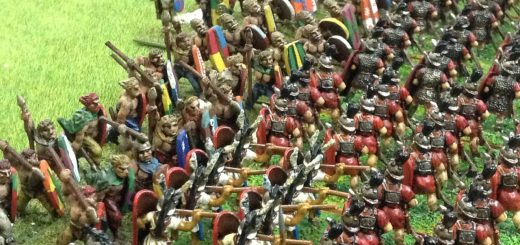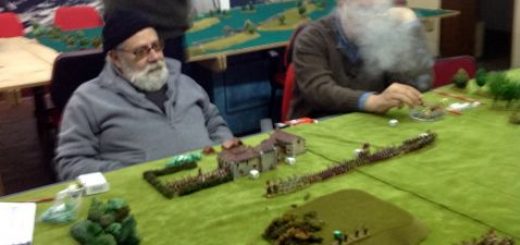Battle for Fiume, Cold War 1986
Cold war scenario liberally shaped around Sir John Hackett Third World War book.
First clash of US vs Soviet troops in former Jugoslavia, city of Fiume (Rijeka). Here is a map of the city and surroundings.
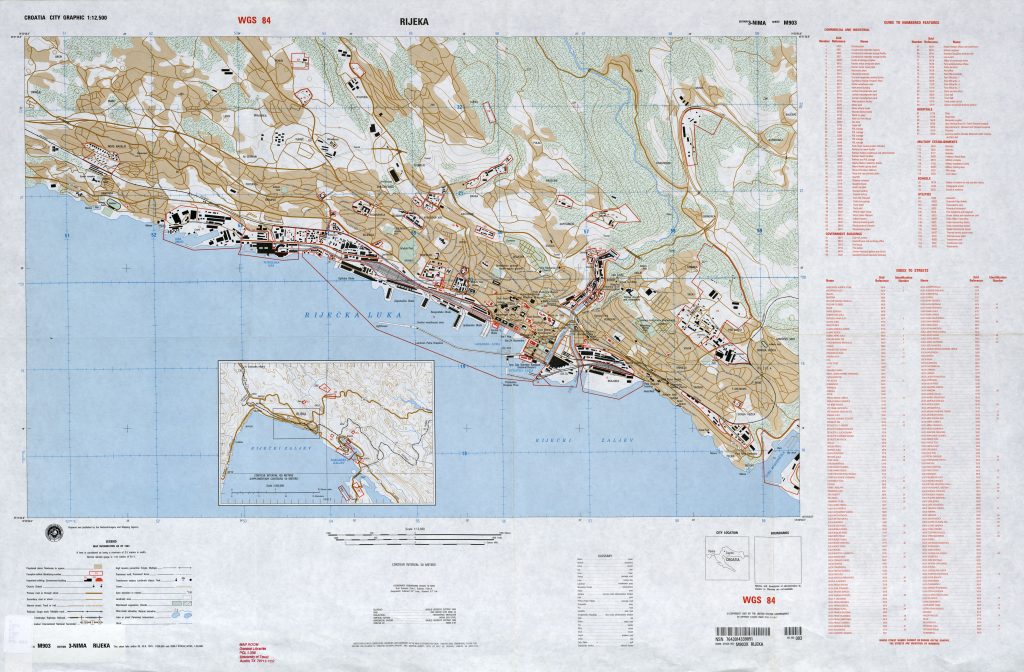
A Marine Battlegoup lands in Fiume to start countering the Soviet invasion of Jugoslavia. In the meantime forces buildup in central Europe fpr the major offensive.
Italian troops are not sent through Adriatic for fear of Jugoslavian population risings.
Soviet airborne troops hurriedly sent from Lubjana advance to counter the american beachhead. A key objective will be the high ground overlooking the port. They come from highway 10-4,12. They have very few helicopters in this region, al large airborne assault has been launched towards Zagreb yesterday and heavy fighting is ongoing to break through the jugoslavian defences in the city.
Most probably the clash for Fiume will happen on the north-west, along the highway leading to the city. This is the only way from north, another road from north-east has been closed by blowing a tunnel.
Game is played in 1/300 scale using Modern Spearhead.
Armies

Soviet AirborneOne airborne regiments plus assets.
US MarinesOne Marine Expeditionary Unit (MEU) plus assets. This photo is an artistic view of a future development of LVTP7.
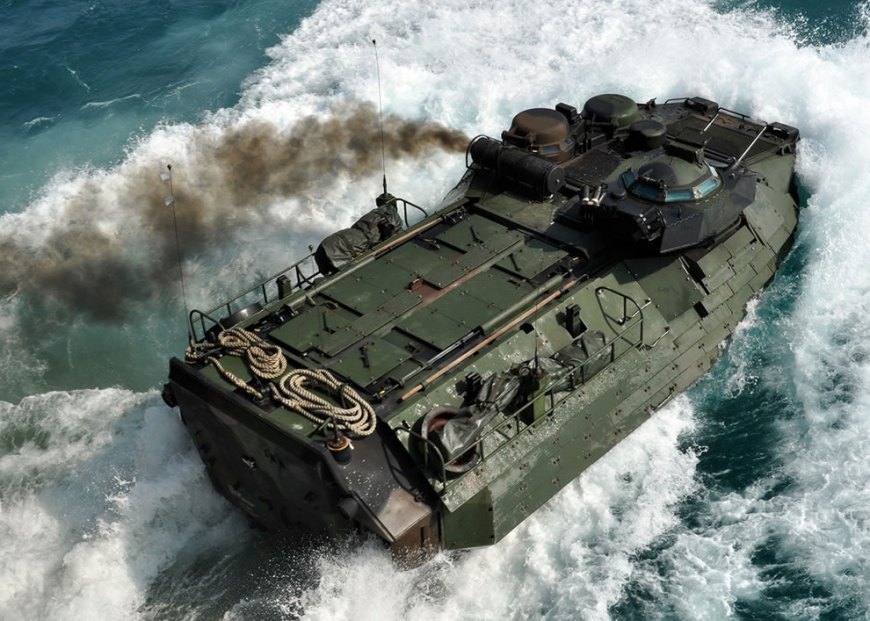
Situation
Soviets arrive from Lubjana road, marching order.
Marines arrive from Fiume city centre, they need to stop the soviets before they enter the city and arrive within dangerous distance from the Main Harbour where beachhead is.
The two sides may have small air assault assets to land in key points in the battle area.
Terrain contains an highway in the middle of a 3-4 km valley, which opens to the sea with villages and city outskirts.Many woods along the valley, up to the city outskirts.
Some high ground away from the sea. have a look at the map. No cultivations, builtup areas.
First airbattles are being fought over the Adriatic, around the task force which has landed the marines. No many assets on the two sides. Some heli flights available. Will not be very useful close to buildings.
Terrain
Below a Map to be used to give orders. Visibility is normally bellow 1km, 10 inches, due to various terrain features mostly woods, broken ground. Visibility increase by 3km, 30 inches every 100m contour. Blocking terrain like buildings, woods still works, but it is possible to see behind a shadow of 3″ (300m).
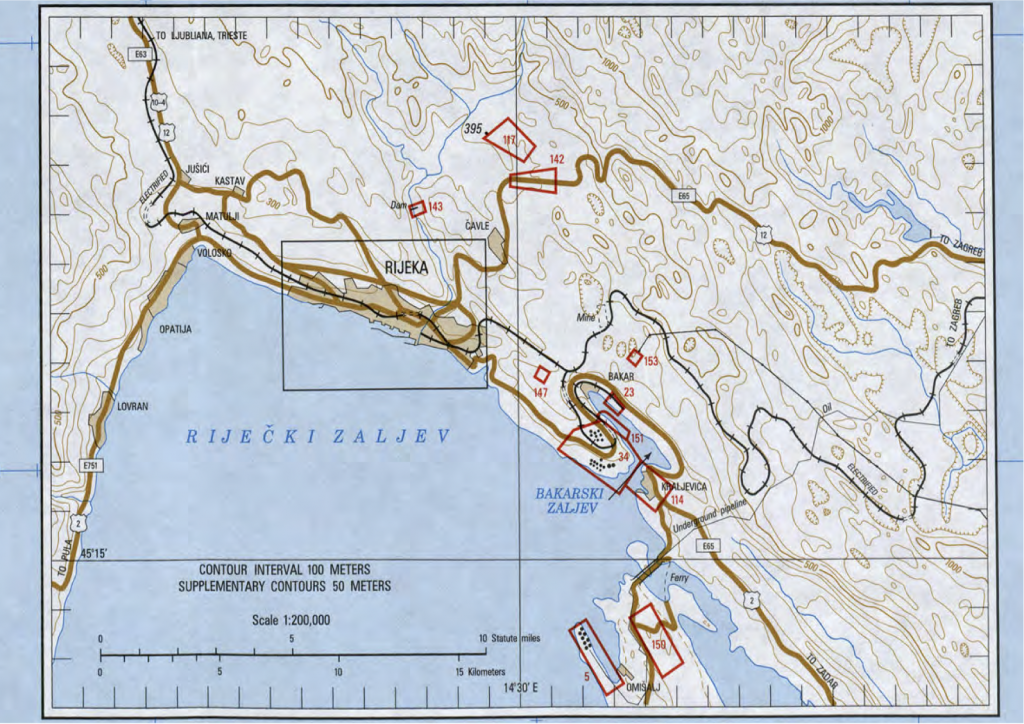
US Marines
US Post 1986 USMC Division
Morale: All Regulars
Regimental Headquarters:
HQ: 1-HQ stand in HMMWV
1-Artillery Observer (AO)
1-Forward Area Controller (FAO)
1-Marine Rifle battalions with:
Battalion headquarters
HQ: 1-HQ stand in HMMWV
2-81mm mortar stands in HMMWV
2-Javelin (post 1999), or 3-Dragon ATGW stands in HMMWV
2-TOW-HMMWV stands1-HMMWV-HMG stand; 1-HMMWV-GL stand
3-Rifle Companies each with:
3-Rifle stands (see notes) on HMMWV
Divisional Assets
1-Receoinnassance Battalion HQ
1-Reconnaissance Company each with:
3-Rifle stands (may be mounted on HMMWV)
1 Armoured Company with:
4-M60A1
1-Combat Engineer Companies, each with:
3-engineer stands with towed MC line charges
1-Artillery Battalions each with:
4-M109 or 155mm towed howitzer (may be mixed)
1-Marine Aircraft Squadron assets
1-Light Attack Helicopter (HMLA) Squadron:
1-UH-1 Iroquois flights
1-AH-1 Cobra flights-Heavy Helicopter Squadrons (HMH) each with:
2-CH-53 Sea Stallion flights
1-Low-altitude Air Defence (LAAD) Battalion
5-Stinger Avenger Stands
3-A6 Intruder Flights. They are available only with 1d6=6 when called, one throw per move when one or more flights are called, due to high soviet interdiction by SAM and fighters.
Notes:
- The USMC will normally deploy as one of three different Task Groups depending on its requirements. They are:
- Marine Expeditionary Units (MEU) â Comprising of: 1 Marine Infantry Battalion plus platoon- or battery-elements of the Divisional assets and one Squadron made up of elements of the Marine Aircraft Group
- Marine Expeditionary Brigade (MEB) â Comprising of: 2 to 5 Marine Infantry Battalions plus supports from the Divisional assets and an entire Marine Aircraft Group
- Marine Expeditionary Force (MEF) â Comprising of: 6 or more Marine Infantry Battalions plus all Divisional assets, an entire Marine Aircraft Group, and 3 fixed wing attack squadrons. It may consist of more than one division
- Towards the latter part of the 1980âs M1 Abrams were on order to replace the M60. In 1990, during the deployment for Desert Storm, a number of M1A1 Abrams were lent to the USMC from the US Army and the replacement schedule was brought forward, although only 1-1/2 USMC battalions of Abrams were used in Desert Storm.
- The USMC division contains an Assault Amphibian Battalion with owns enough AAV for 3 Infantry Battalions plus the Reconnaissance Battalion and a stand of engineers. An assault amphibian platoon has 10 vehicles, enough to mechanise a reinforced rifle company. Therefore these units may be represented as AAAV-7 (USMC upgrade) combat teams, or in trucks, or on foot (heliborne). The Reconnaissance Battalion may be deployed in HMMWV or AAV. Prior to 1999 there was only a recce company at division level, and each regiment had a recce platoon.
- Fixed wing support is dependant on the scenario and may comprise of AV-8 Harriers, F-18 Hornets or A-6 Intruders
- The CH-46 Sea Knight has a defence of 3, no offensive capability and can carry 2 infantry stands
Soviet Airborne
1980s Soviet Airborne Division
Division assets
Airborne Artillery Regiment
1-Howitzer Battalion: 3-D30 122mm towed howitzer stands; 1-M1975 MRL stand
1-Artillery Observer (AO)
1-Mi24 Flight
1-Mi8 Flight
3-SU25 Flights
1-Forward Air Controller (FAO)
1-HQ ASU-85 or 2S9, 2-ASU-85 or 2S9 stands
Elements of Anti-Aircraft Battalion: 3-SA-7/14 stands in GAZ66 (later BTR-3D)
Elements of Engineer Battalion: 2-Engineer Companies, each: 2-Engineer stands
Recce Company: 2-BRDM2; 1-Infantry stand in GAZ66
1-Airborne Regiment:
Regimental HQ: 1-HQ stand in BMD 1979/3; 1-SA-7/14 stand in BMD
ATGM Battery: 3-BRDM-3 stands
Mortar Battery: 3 stands 2S9 battalion
Air Defence Battery: 1-ZU-23 towed stand (later mounted portee on BTR-D)
Engineer Company: 2-Combat Engineer stands in GAZ66
Pathfinder Platoon: 1-elite infantry stand (may have BRDM)
3-Airborne Battalions, each:
Battalion HQ: 1-HQ stand in BMD M1979/3
Mortar Platoon: 1-82mm mortar stand in GAZ66
Air Defence Platoon: 2-SA-7/14 stands in BMD
AutoGL Platoon: 1-AGS-17 stand in BMD M1979/1
3-Infantry Companies, each: 2-BMD infantry combat teams
NOTES:
1. The rules for Soviet trained organisations apply.
2. BMD-1 was approved for service in 1969. BMD-1P with Spandrel/Spigot was produced from 1975-1985. BMD M1979/3 also known as BMD-1KSh “Sorokha” actually was approved for service in 1975. In 1984 the BMD-2 entered batch production. The BMD-3 was in production only from 1990.
3. In the late-80s the Regimental AT gun battery disappeared and the ATGM battery was equipped with 3-Spandrel+Spigot/BTR-RD stands vice the BRDM3. BTR-RD “Robot” was in service from 1983 replacing ASU-85 and SD-44 85mm.
4. In the late-80s the Divisional ATGM battalion had three of the above ATGM batteries with Spandrel+Spigot .
5. By the late-80s the airborne infantry regiments had a battalion of 4-2S9 stands instead of the mortar battery. Airborne infantry battalions had no 82mm mortars. The divisional artillery regiment also had a battalion of 2S9s and a battery of 1-D30 stand. No MRLs.
6. 2S9 entered service from 1981. In 1982 it was joined by the 1V119 “Reostat” battery recce and fire control vehicle, also supplied to airborne recce troops.
7. BTR-3D “Skreshet” was introduced from 1984 to carry MANPADS teams.
8. Many Soviet Airborne troops in Afghanistan rapidly exchanged their BMDs for BMPs.


